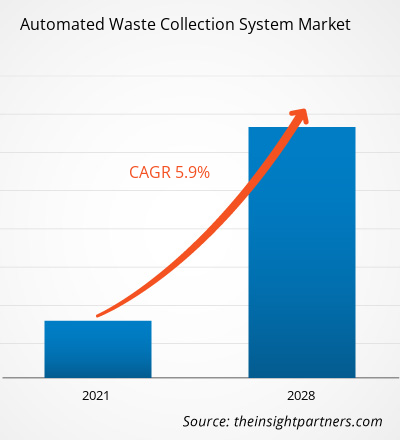2020 年,自动化垃圾收集系统市场价值为 2.3488 亿美元,预计到 2028 年将达到 3.6537 亿美元;预计 2021 年至 2028 年期间的复合年增长率为 5.9%。
推动自动化垃圾收集系统市场发展的关键因素是政府为妥善处理垃圾而采取的举措。世界各地的政府机构都制定了垃圾收集和分类的规章制度。例如,印度政府制定了新的固体废物管理规则,强调在源头对垃圾进行分类。新法规要求在源头对垃圾进行分类,以便通过回收、再利用和再循环将其转化为资本。因此,在将垃圾交给收集者之前,垃圾产生者必须将其分类为三类——可生物降解垃圾、干垃圾(塑料、纸张、金属、木材等)以及家庭有害垃圾(尿布、餐巾纸、驱蚊剂、清洁剂等)。然而,大规模垃圾分类是一个繁琐的过程,这迫使政府部门将重点放在垃圾分类的自动化解决方案上。这些因素正在影响全球许多国家对自动化垃圾收集系统的采用。
自定义此报告以满足您的要求
您将免费获得任何报告的定制,包括本报告的部分内容,或国家级分析、Excel 数据包,以及为初创企业和大学提供超值优惠和折扣
自动垃圾收集系统市场: 战略洞察

- 获取本报告的主要市场趋势。这个免费样本将包括数据分析,从市场趋势到估计和预测。
新冠疫情对自动垃圾收集系统市场的影响
您将免费获得任何报告的定制,包括本报告的部分内容,或国家级分析、Excel 数据包,以及为初创企业和大学提供超值优惠和折扣
自动垃圾收集系统市场: 战略洞察

- 获取本报告的主要市场趋势。这个免费样本将包括数据分析,从市场趋势到估计和预测。
然而,由于地区和地方政府鼓励市政当局和私人组织投资智能垃圾或垃圾收集和分类解决方案,全球各地的自动垃圾收集系统制造商受到的冲击有限。随着住宅垃圾量大幅增加,住宅领域对自动垃圾收集系统的需求飙升。然而,由于人员流动受限导致供应链中断,导致美国、加拿大、英国、意大利和中国等发达国家和发展中国家的自动垃圾收集系统 (AWCS) 部署和安装速度均有所放缓。此前,全球自动垃圾收集系统市场的收入增长趋势低于往常。
市场洞察——自动垃圾收集系统市场对自动垃圾收集系统集成的投资不断增加
自动垃圾收集系统在医疗机构中越来越受欢迎。垃圾管理和收集系统以每小时 60 英里的速度通过密封的专用管网将物料从病房的装卸站输送到中央收集点。垃圾、堆肥和脏污的衣物通过单独的路径运送到相应的收集箱。这促使酒店、医疗保健和零售等行业对自动收集技术的投资不断增加。例如,Logiwaste AB 已向斯德哥尔摩卡罗琳斯卡医院提供了三种不同的自动垃圾收集系统。这些系统预计将处理四种不同类型的垃圾,即残余垃圾、纸张、塑料和纸质包装。Logiwaste AB 还赢得了特隆赫姆 Tiller Öst、卡尔斯塔德中心医院、特隆赫姆 Grilstad Marina 和北京中国人寿的自动垃圾收集系统 (AWCS) 供应合同。同样,Atreo 也获得了为帕克兰医院、亨伯河医院、布莱根妇女医院和德克萨斯大学西南医学中心等机构供应 AWCS 的项目。因此,预计不同行业(尤其是医疗保健行业)的组织在实施自动废物收集和管理系统方面的投资不断增加,将在未来几年推动市场的增长。
基于产品类型的洞察
根据产品类型,自动废物收集系统市场分为固定式和移动式。固定式部分在 2020 年占据了更大的市场份额。
基于内容质量的洞察
根据最终用户,自动废物收集系统市场分为机场、教育机构、医院、公司办公室、酒店/餐厅等。预计机场部分在预测期内的复合年增长率最高。
自动废物收集系统市场的参与者主要专注于开发先进高效的产品。
- 2021 年,Caverion 为生物技术公司 Thermo Fisher Scientific Baltics 的新大楼实施了一个交钥匙工程。该项目在立陶宛维尔纽斯开展。
- 2021年,斯塔万格大学医院选择了Logiwaste AB的自动垃圾和衣物收集系统。该系统从进料门一直到终端,提供用户友好、高效且卫生的垃圾和衣物处理方式。
自动垃圾收集系统市场
The Insight Partners 的分析师已详尽阐述了预测期内影响自动垃圾收集系统市场的区域趋势和因素。本节还讨论了北美、欧洲、亚太地区、中东和非洲以及南美和中美洲的自动垃圾收集系统市场细分和地域分布。
自动垃圾收集系统市场报告范围
| 报告属性 | 细节 |
|---|---|
| 市场规模 2020 | US$ 234.88 Million |
| 市场规模 2028 | US$ 365.37 Million |
| 全球复合年增长率 (2020 - 2028) | 5.9% |
| 历史数据 | 2018-2019 |
| 预测期 | 2021-2028 |
| 涵盖的领域 |
By 产品类型
|
| 覆盖地区和国家 | 北美
|
| 市场领导者和主要公司简介 |
|
自动垃圾收集系统市场参与者密度:了解其对业务动态的影响
自动化垃圾收集系统市场正在快速增长,这得益于终端用户需求的不断增长,而这些需求的驱动因素包括消费者偏好的不断变化、技术进步以及对产品优势的认知度不断提高。随着需求的增长,企业正在扩展产品线,不断创新以满足消费者需求,并抓住新兴趋势,从而进一步推动市场增长。

- 获取 自动垃圾收集系统市场 主要参与者概述
- 固定式
- 移动式
自动废物收集系统市场 - 按最终用户
- 机场
- 教育机构
- 医院
- 公司办公室
- 酒店/餐厅
- 其他
自动废物收集系统市场 -按地理
北美洲
- 美国
- 加拿大
- 墨西哥
欧洲
- 德国
- 法国
- 意大利
- 英国
- 俄罗斯
- 其他地区欧洲
亚太地区 (APAC)
- 澳大利亚
- 中国
- 印度
- 日本
- 韩国
- 亚太地区其他地区
中东和非洲 (MEA)
- 沙特阿拉伯半岛
- 阿联酋
- 中东和非洲其他地区
南美洲(SAM)
- 巴西
- SAM 其他业务
公司简介
- Aerbin ApS
- AMCS 集团
- Caverion 公司
- Envac AB
- Logiwaste AB
- MariMatic Oy
- MEIKO
- Evac 集团
- MABAT
- STREAM 环境
- 历史分析(2 年)、基准年、预测(7 年)及复合年增长率
- PEST和SWOT分析
- 市场规模、价值/数量 - 全球、区域、国家
- 行业和竞争格局
- Excel 数据集
近期报告
客户评价
购买理由
- 明智的决策
- 了解市场动态
- 竞争分析
- 客户洞察
- 市场预测
- 风险规避
- 战略规划
- 投资论证
- 识别新兴市场
- 优化营销策略
- 提升运营效率
- 顺应监管趋势






















 获取免费样品 - 自动垃圾收集系统市场
获取免费样品 - 自动垃圾收集系统市场